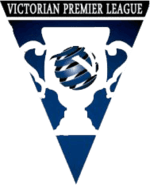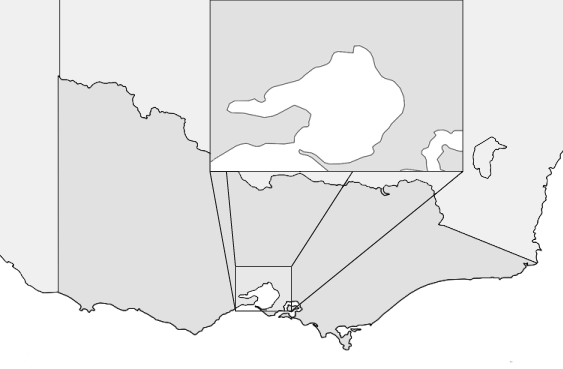National Premier Leagues Victoria
| Founded | 1908 |
|---|---|
| First season | 1909 |
| Country | Australia |
| Number of teams | 14 |
| Level on pyramid | 2 |
| Relegation to | NPL 2 |
| Domestic cup(s) |
FFA Cup Dockerty Cup |
| Current champions | Heidelberg United FC (2018) |
| Current premiers | Heidelberg United FC (2018) |
| Most championships | South Melbourne (10 titles) |
| TV partners |
Flip TV FFV Radio |
| Website | NPL Victoria |
|
| |
The National Premier Leagues Victoria is an Australian professional association football league comprising teams from Victoria. As a subdivision of the National Premier Leagues, the league sits at Level 1 on the Victorian league system (Level 2 of the overall Australian league system). The competition is administered by Football Federation Victoria, the governing body of the sport in the state. In 2014 the league was rebranded from the Victorian Premier League to reflect the league joining the National Premier Leagues.
History

The league commenced in 1909 with Carlton United being the first champions. It has run continuously except for a three season postponement from 1916 to 1918 owing to World War I. After 1945 the league, like fellow state competitions around the country, received a massive boost in numbers and quality with the post-war influx of European migrants, whose dominance was established so effectively that no club which had won the title before 1952, Juventus' first title, has won one since.
Juventus would go on to dominate the league in the 1950s, winning six titles, including five in a row from 1952 to 1956. In 1958, after the Victorian Amateur Soccer Federation was formed, the league became known as the Victorian State League. From 1962 until 1976 the league was largely dominated by South Melbourne Hellas and Footscray JUST, which won 11 titles between them.
With creation of the National Soccer League (NSL) in 1977, the league gradually lost most of its stronger clubs, a trend that reached its peak between 1984 and 1986, when the NSL used a split conference system. After 1987, however, the league slowly started regaining clubs, firstly those discarded when the conference system experiment was abandoned and later when clubs became permanently relegated by the NSL to their respective state leagues. The dominant side during the years from 1977 to 2004 was Green Gully, who won six titles during this period, despite also missing the years 1984–1986 from being in the NSL.
In 1991 the league rebranded again to become the Victorian Premier League and the first finals to determine the champions were staged in 1992, won by the newly promoted North Geelong. Following the demise of the NSL in 2004, the remaining two Victorian NSL teams Melbourne Knights and South Melbourne were granted permission to play in the VPL season of 2005. The league received a major boost at the start of the 2005 season when Vodafone became major naming rights sponsors, with the competition being renamed the Vodafone Cup. The 2005 season initially saw crowds attending in record numbers to witness the return of old derbies such as that between South Melbourne and Heidelberg United, but with the formation of the A-League filling the void of a national domestic league, 2006 saw a sharp decline in attendances.
The end of the 2006 season also witnessed a controversial finish to the relegation battle. With three teams finishing on 30 points, Sunshine George Cross were relegated on goal difference. However, a post-season appeal to the tribunal on the grounds that Essendon Royals had fielded a suspended player (Ilcho Mladenovski in round 24) saw the Royals deducted a point and relegated. Ultimately, both clubs reprised their position in the following season's competition with the inclusion of the Australian Institute of Sport evening out the numbers to 16, and as the first part of reforms to the competition set to be brought about in 2008.
The Australian Institute of Sport experiment was largely derided by the local clubs, and after their removal from the competition in 2008, the league reverted to 12 teams and a Top 5 Finals-Series in 2009. However, the concept of a youth development squad was reintroduced in 2010 with the National Training Centre team playing in midweek fixtures throughout the season but not for competition points. In 2011 the team, mostly comprising players from the Melbourne Victory youth squad, was renamed Victorian Training Centre Football and was eligible to score competition points for its matches but ineligible to qualify for the finals series or be relegated.
On 15 September 2013, Victoria Police arrested up to ten people, including Southern Stars FC players David Obaze, Nicholas McKoy and Joe Woolley as well as the coach, Zaya Younan, for allegations of match fixing. They are expected to be charged with corrupting the outcome of betting.[1]
In early 2013, it was announced that Victoria would join the National Premier Leagues, with the Victorian Premier League expected to be rebranded for the 2014 season.[2][3] Although Football Federation Victoria's initial proposal was halted with the announcement of a deferral in November 2013 after several clubs objected to the process for selecting team. However, by December 2013, a resolution was reached whereby Victorian teams would participate in the 2014 season.[4][5]
Format
The league sits below the A-League and forms a part of the second tier of league soccer in Australia. It is primarily staged in the Australian winter and, in its current format, runs between March and September. The league comprises teams based in the Australian state of Victoria and Football Federation Victoria is the governing body.
The introduction of the NPL by Football Federation Victoria in 2014 resulted in twenty eight licences being issued and accepted by clubs divided into two divisions: NPL and NPL1. Two teams (Eastern Lions and Surf Coast) were offered licences however decided not to accept them.[6] In 2016 to avoid confusion the divisions were renamed as NPL and NPL2.
NPL and NPL2: The NPL comprises fourteen teams competing in a Seniors and an Under 20s competition. Every team plays each other twice over the course of a 26-week season. NPL2 consists of 20 teams competing in a Seniors and an Under 20s competition. The league consists of two conferences, divided into East and West with 10 teams in each conference. Every team plays a team in their own conference twice, while cross-conference matches occur which sees teams play teams in the opposing conference once over the course of a 28-week season.
Finals
Victorian Finals: A finals series was re-introduced in 2015 for the top 6 teams. There is no finals series for the NPL2.
National NPL Finals: The Victorian NPL champion represents Victoria in the Australian National Premier Leagues finals. In 2014 the first round of NPL national finals saw Victoria play Tasmania's NPL champion. Since 2016 the match ups in the national finals series have been randomly drawn.
Promotion and Relegation: The teams in the NPL occupying 13th and 14th ladder positions at the conclusion of the season are automatically relegated to NPL2. Conference winners from NPL2 East and West replace the relegated teams. The team which occupies the 12th ladder position at the conclusion of the NPL season will be required to play a promotion relegation play-off against the winner of the play-off between 2nd placed NPL2 East and West sides, with the winner of the play-off earning the right to play in the NPL.
Teams finishing last in their NPL2 conference may be relegated to State League 1, which would depend on the ability of the State League 1 sides who finish in the top 2 positions to meet NPL licensing criteria.
Current clubs (2018)

| Club | Location | Home ground | Capacity |
|---|---|---|---|
| Avondale | Parkville | Avengers Park | Unknown |
| Bentleigh Greens | Cheltenham | Kingston Heath Soccer Complex | 5,000[7][8] |
| Bulleen Lions | Bulleen | David Barro Stadium | 6,000 |
| Dandenong Thunder | Dandenong South | George Andrews Reserve | 5,000 |
| Green Gully | Keilor Downs | Green Gully Reserve | 10,000 |
| Heidelberg United | Heidelberg West | Olympic Park | 12,000 |
| Hume City | Westmeadows | ABD Stadium | 5,000 |
| Kingston City | Clayton South | The Grange Reserve | 2,000 |
| Melbourne Knights | Sunshine North | Knights Stadium | 15,000 |
| Northcote City | Thornbury | John Cain Memorial Reserve | 9,000 |
| Oakleigh Cannons | Oakleigh | Jack Edwards Reserve | 5,000 |
| Pascoe Vale | Fawkner | CB Smith Reserve | 2,000 |
| Port Melbourne | Port Melbourne | SS Anderson Reserve | 1,000 |
| South Melbourne | Albert Park | Lakeside Stadium | 12,000 |
Honours
| Year | Premiership | Champions | NPL Finals Representation |
|---|---|---|---|
| 2014 | South Melbourne | – | South Melbourne - Semi Finalist |
| 2015 | South Melbourne | Bentleigh Greens | South Melbourne - Quarter Finalist |
| 2016 | Bentleigh Greens | South Melbourne | Bentleigh Greens - Quarter Finalist |
| 2017 | Heidelberg United | Bentleigh Greens | Heidelberg United- Champions |
| 2018 | Heidelberg United | Heidelberg United | Heidelberg United - Semi Finalist |
Honours pre-NPL (1909-2013)
Former Clubs (1963 onwards)
- Albion Leyland/Albion Rovers/Albion Turk Gucu/Melton Reds (1978–79, 1982–1985, 1990–1997)
- Altona City (1977–1981)
- Altona East Phoenix (1999–2003)
- Altona Gate/Altona Magic (1989–2010)
- Australian Institute of Sport (2007–2008)
- Box Hill (1969–1973, 1983–1990, 1995–1996)
- Broadmeadows (1984)
- Broadmeadows City (1987)
- Brunswick Juventus/Juventus (1963–1983, 1989–93)
- Bulleen Zebras (1998–2006)
- Caulfield City (1986–1990, 1993)
- Croydon City (1979–84)
- Doncaster Rovers (1995)
- Doveton (1981–1984, 1991)
- Essendon Lions/Lions (1962–1971)
- Essendon Royals/Triestina (1964–1965, 2001, 2003–2007)
- Fawkner Blues (1983–2004, 2007–2008)
- Fawkner-Whittlesea Blues (2005–2006)
- Fitzroy Serbia/Fitzroy City (2002)
- Footscray JUST/Melbourne City JUST (1963–1976, 1990)
- Frankston City (1977–1982)
- Frankston Pines (1984–1987, 1989–1990, 2003–2006, 2008)
- Goulburn Valley Suns FC (2014)
- Hakoah. St Kilda/St. Kilda Hellas-Hakoah (1963–1982)
- Keilor Austria/Austria (1972–1974)
- Knox City (1984–1985, 1992–1993, 2004)
- Maribyrnong Polonia/Polonia (1963–77, 1982–1989)
- Melbourne/Melbourne Hungaria (1963–1975, 1986)
- Melbourne Raiders (1999–2000)
- Melbourne Victory Youth (2016)
- Moorabbin City (1998)
- Mooroolbark/Mooroolbark United (1974–1976, 1990–1991)
- Morwell Falcons (1982–1992)
- North Geelong Croatia/North Geelong Warriors (1992–1997, 2015, 2017–)
- Port Melbourne Slavia/Prahran Slavia (1963–1970, 1973–80)
- Preston Makedonia/Preston Lions (1967, 1976–80, 1994–1995, 1997–2009)
- Richmond SC/Alemannia Richmond (1963, 2006–2013, 2016)
- Ringwood City FC (1963–1966, 1968–1986, 1988–1990)
- South Dandenong/Dandeong Thunder (1998–1999, 2001, 2009–2015)
- Springvale City (1985–1989, 1993–1996)
- Springvale White Eagles (1997–1999, 2007, 2011)
- St. Albans Saints (1984–2005, 2011, 2017–)
- Sunshine City (1975–1982)
- Sunshine Georgies/Sunshine George Cross (1958–1983, 1992–1999, 2005–2007, 2009–2010)
- Thomastown Zebras (1985–1994, 1996–1998)
- Werribee City Bees (1994–1995)
- Western Suburbs SC (1980, 1984–1988, 2007–2008)
- Westvale (1999)
- Whittlesea Stallions (2002–2004)
- Whittlesea Zebras (2007–2009)
References
- ↑ The Age newspaper
- ↑ "Gallop aims for Aussie FA Cup". The Australian. Australian Associated Press. 14 February 2013. Retrieved 23 December 2013.
- ↑ "Second Division 'By 2022'?". Australian FourFourTwo. Sportal Australia. 3 October 2012. Retrieved 23 December 2013.
- ↑ "NPL update – message from FFV Board". Football Federation Victoria. 8 November 2013. Retrieved 4 December 2013.
- ↑ "National Premier Leagues confirmed for Victoria in 2014". Football Federation Australia. 6 December 2013. Archived from the original on 24 December 2013. Retrieved 23 December 2013.
- ↑ http://www.foxsportspulse.com/assoc_page.cgi?client=1-10178-0-0-0&sID=317230&&news_task=DETAIL&articleID=28122563
- ↑ "Kingston Heath Soccer Complex". Austadiums. Retrieved 17 February 2016.
- ↑ "KINGSTON HEATH SOCCER COMPLEX". Soccerway. Retrieved 17 February 2016.
External links
- Results site
- VPL TV, official online broadcaster